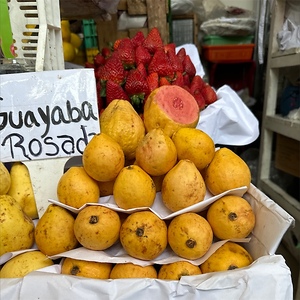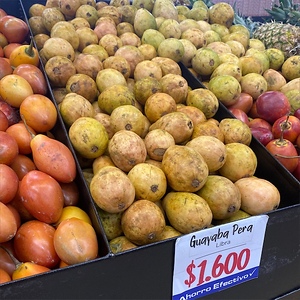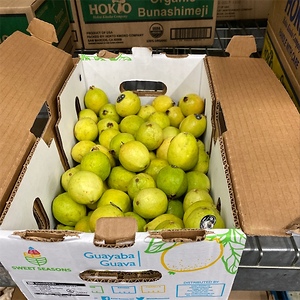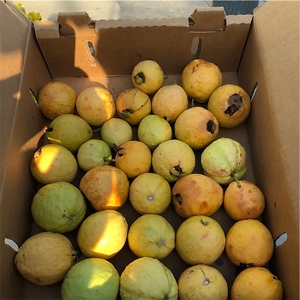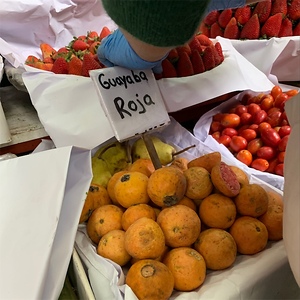

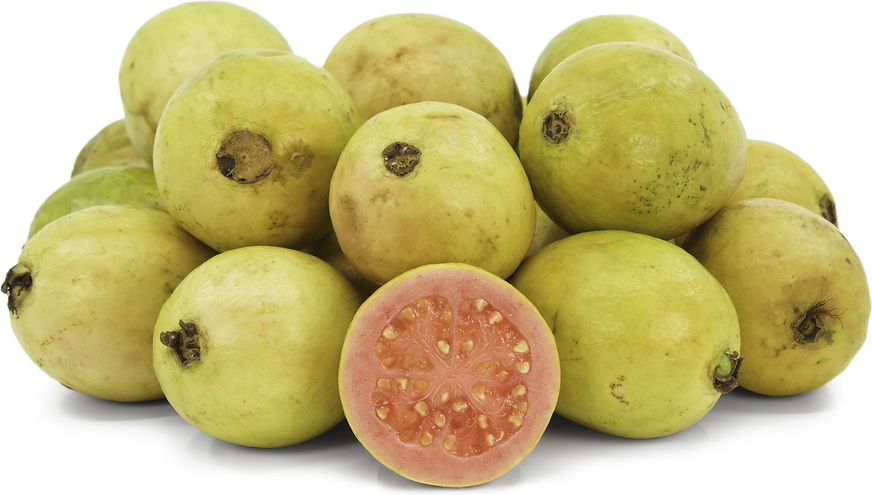
Guayaba
Estimated Inventory, lb : 0
This item was last sold on : 12/22/22
Description/Taste
Guayaba Rojas are small to medium in size, averaging eight centimeters in diameter, and are round to oval in shape. The skin ripens from green to yellow-orange when mature and is semi-smooth to rough, with an uneven surface pocked with marks and dents. Underneath the surface of the thin skin, the flesh is red-pink, grainy, juicy, and filled with many small yellow-brown seeds. When ripe, Guayaba Rojas are aromatic with a musky, honeyed fragrance and have a creamy texture with a sweet, tropical, and slightly acidic flavor reminiscent of strawberries, pears, and citrus.
Seasons/Availability
Guayaba Rojas are available year-round.
Current Facts
Guayaba Roja, botanically classified as Psidium guajava, are the fruits of an evergreen shrub or tree that can reach up to ten meters in height and belongs to the Myrtaceae family. Also known as the Common Guava, Red Guava, and Lemon Guava, Guayaba Roja is a favorite fruit of Peruvians for its sweet flavor and is commonly consumed fresh, juiced, or incorporated into confectionaries and desserts. The Guayaba Roja shown in the photo above is just one of many varieties of guava found in Peru, and other popular varieties include the white guava and the strawberry guava.
Nutritional Value
Guayaba Roja is an excellent source of vitamin C and fiber, and also contains calcium, phosphorus, and some iron.
Applications
Guayaba Roja can be consumed raw and is commonly sliced and tossed into green and fruit salads, chopped into salsa, or is eaten fresh, out-of-hand. The sweet, tangy fruit can also be juiced and mixed with other tropical juices as a refreshing agua fresca, stirred into punches, or used to flavor cream sodas. In addition to juices, Guayaba Roja’s sweet flavor is often used to flavor bread, pastries, ice cream, and desserts, and the fruit is high in pectin allowing it to be used in jams, jellies, and marmalades. The fruit can also be cooked and used in curries and stir-fries or topped over meats such as steak or shrimp for a tropical twist. Guayaba Roja pairs well with lime, pineapple, citrus, coconut, peppers, garlic, onion, and balsamic vinegar. The fruits will keep up to a week at room temperature, depending on the degree of ripeness, and once ripe they should be stored in the refrigerator where they will keep for an additional two days.
Ethnic/Cultural Info
In Peruvian markets, Guayaba Roja is often stacked in small or large groupings to showcase the fresh fruit’s bright colors and highly fragrant, musky aroma. Consumed in Peruvian diets since pre-Incan times, guayabas are valued for their high fiber content and have been used as a natural remedy to improve digestion. In modern day, the fruits are popularly juiced in the market with the pulp included in the drink as a source of fiber or the fruit is consumed whole with the skin on, similarly to an apple. Drinks with guayaba juice such as agua fresca have also become one of the most popular market items in Central and South America as a refreshing beverage on hot, humid days.
Geography/History
The origins of guayaba are mostly unknown as it has been growing wild since ancient times in the Americas and was believed to have been spread by animals and migrating peoples. Experts believe the fruit is native to regions of Mexico spreading down through Central America and into South America. Today Guayaba Roja is found growing wild in Peru and is also cultivated on a small scale in Lima, Cusco, Junin, Loreto, San Martin, and Huanuco. It can also be found in Central America, Mexico, the United States, the Caribbean, Asia, Southeast Asia.
Recipe Ideas
Recipes that include Guayaba. One



